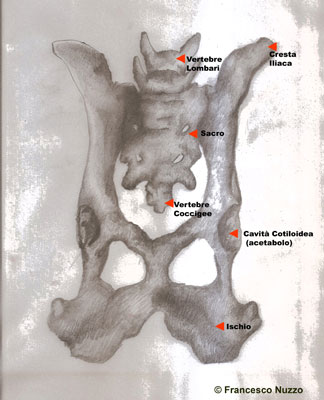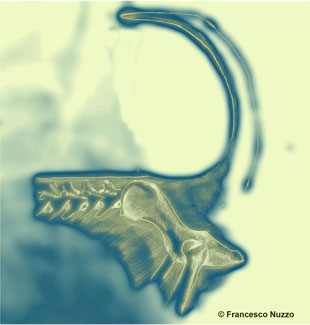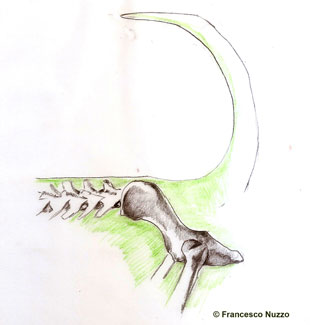- WELCOME
- HOME
- ABOUT US
- CHAMPIONS
-
VERY IMPORTANT DOG
- Ch. South Fork's Jelly Bean
- Ch. South Fork's The Beat Goes On
- Ch. Yo Te Quiero Di Rio Galeria
- Ch. South Fork' Jazz It Up
- Ch. Tocai Di Rio Galeria
- Ch. South Fork's Contradiction
- Ch. South Fork's Music Man
- Ch. El Nino Di Rio Galeria
- Ch. Xsaraja Di Rio Galeria
- Ch. De Gozette Lotus
- Ch. Eldorado Di Rio Galeria
- Ch. Jaqueline Di Rio Galeria
- Ch. Dacarella's Hellf Angel
- SHOW RESULTS
- PUPPIES
- INFO CHIHUAHUA
- CONTACTS
- TOOLS
Dog Expertise
By Paolo Tartaro and Francesco di Paola Nuzzo
- Source: Magazine All About Chihuahua n° 6
| We came to the description, as announced in the fifth issue of AAC, of the two regions of the trunk: the loins and the croup, recalling that they have a fundamental importance in the transmission of the movement. We will analyze, in terms of dog-science, the lumbar and sacral vertebrae, uneven and short bones, that are the anatomical bone basis of the two regions. |
|
 |
LUMBAR VERTEBRAE & LOINS |
| Obviously, therefore, that the loins, in Chihuahua, as in all other breeds, must be solid, that is short and flexible, but not oscillating in motion The short loin offer greater resistance and strength to movement and. long loins do not favor the motor impulse to the front and, consequently, it can sometimes be observed in the hind uncoordinated movement with the rest of the trunk. Absolute value of the renal region is a good width, because this shows that this portion of the muscles are well developed, not only in length but in width, so the transverse processes of the seven lumbar vertebrae are well developed and it is important, because on them the insertion of the muscles of the region. takes place. The upper profile of the lumbar region in Chihuahua should be slightly bent to facilitate relaxation and contraction in motion, the loins are in harmony with the back and rump, with no interruptions In zoo-technical checks often the term long kidney is used when the trunk is too long. Do not be superficial in assessing the underlying causes of the long loins (or long kidney). One reason is the increased development in the longitudinal direction of the body of the individual vertebrae, while remaining seven in number, this evidently causes the elongation of the region It may happen, what happens to the neck of the giraffe, seven cervical vertebrae are present, as in Chihuahua,, but the giraffe neck is much longer just because of the particular length of the vertebral bodies. The kidney may appear (but not be) long when the chest is underdeveloped in depth. |
As mentioned in the previous issue of AAC (.... The greater the distance between the ribs, the greater the depth of the chest, decisive for the length of the trunk ...) inter-costal spaces determine the length of the side. Sacral vertebrae & croup |
|
| In zoo-technical testing of this specific region, as well as good length, width and angle, the muscle development of the croup is valued, which is crucial because the muscles of this region, in the the phases of gaits and movements are subjected to two motions of great importance: distension and retraction. A long muscle has greater contraction and elongation so more power (a subject already discussed in detail in the fourth issue of AAC). The length of the croup is measured from the tip of the ilium to the ischium. Sagittal development of the croup can be considered valuable not only in Chihuahua, but in all breeds, because the length of this region acts as a mechanical lever arm of the power resulted from the muscles, facilitating a correct transmission of the movement, pushing and raising the trunk. (Croup long means long muscles and so we will have greater contraction). Moreover, as shown by the study of the animal science , the length and direction of the coxal are proportional to the length of the muscles, thus promoting greater extension and contraction. A proper width of the croup expresses a proper development of the bone structure and muscular system of this region, otherwise a close croup denotes inadequate bone and muscle development. The width of the croup is absolute value, and it is measured between the outer tips of the hips. |
|
| The proper development of the transverse diameter of this part of the body requires a wide pelvis, fundamental prerogative in females to facilitate birth giving. Its width should never be greater than its length. The inclination is certainly the cornerstone for the locomotor system of the dog. In most cases, dogs that have strength, is horizontal, in chihuahuas the upper profile of the croup is nearly at the level of the loin and back. The Chihuahua described in the standard has the croup wide and strong , nearly horizontal or slightly inclined. These features (horizontal or slightly inclined) provide high insertion of the tail, and promote faster pace, which is as it appears in the chihuahua breed standard (... long distance, flexible, energetic and active ....) In dog-science ranking the croup is considered horizontal when when the thigh it is between 15 ° to 25 °, and is considered angled when it is between 35 ° to 45 °. Keep in mind that the slope of the croup affects all corners of the rear and therefore modifies the motion. In this sixth issue is even more clear that all the individual regions and subregions are subjected to rules imposed by the anatomy, the static and dynamic, indispensable for reasons of functionality, shape and type. Every single part of the body is connected to another and depends inextricably on the other. An incorrect region will determine the presence of at least one other incorrect region of the body to rebalance (almost never at all) the system as a whole. |
 |
diriogaleria@chihuahua.it | musicvelvet@chihuahua.it
Words and images ©2011 Di Rio Galeria & Music Velvet Kennels - All rights reserved | Web site by TwentyfourCatsandDogs ©

